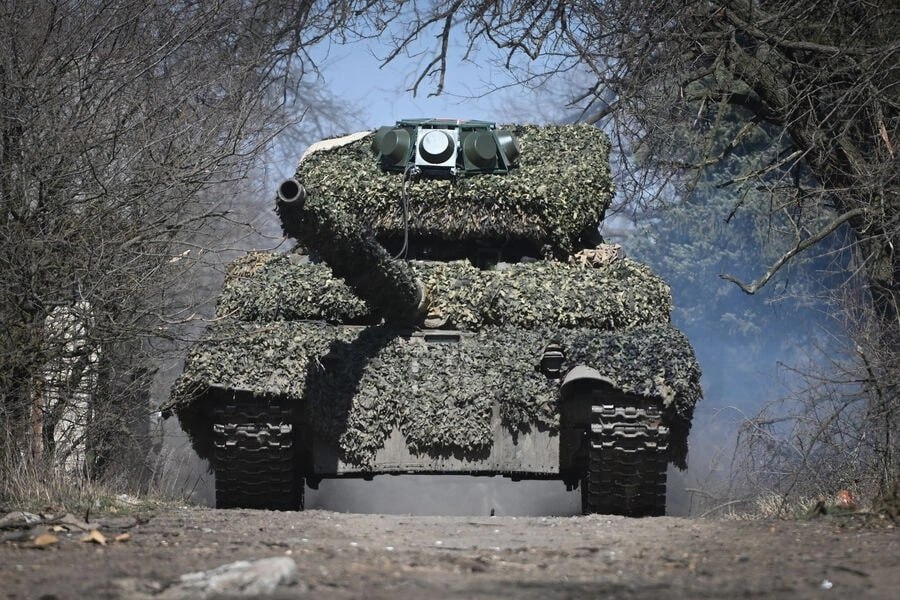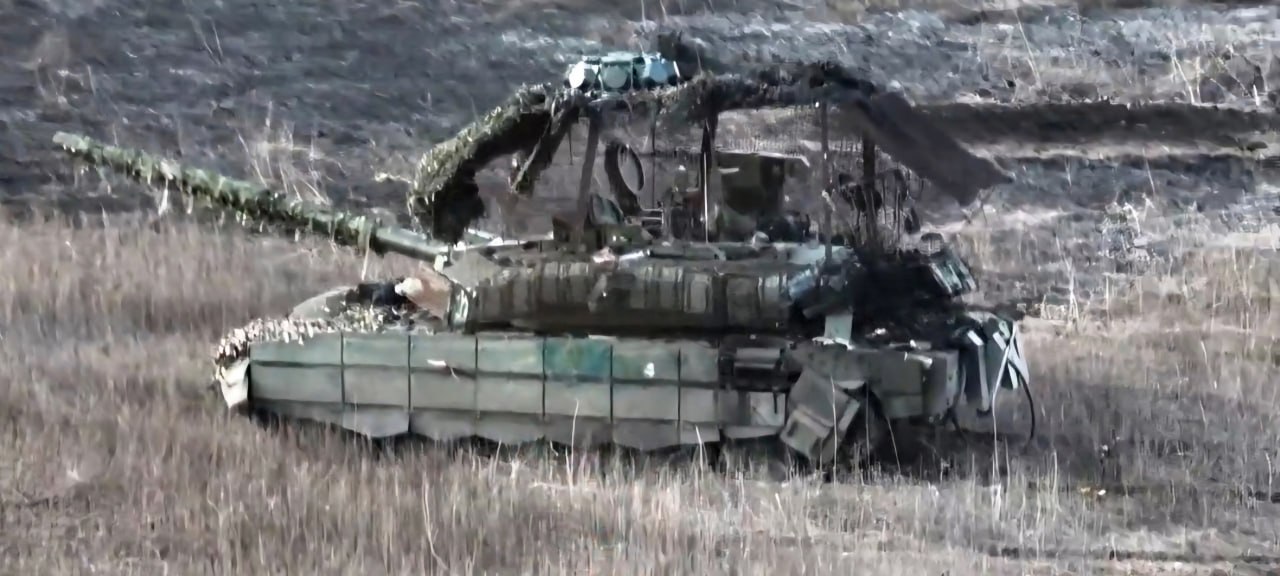To jam incoming Ukrainian kamikaze unmanned aerial vehicles (UAV), which have emerged as the greatest disruptors on the battlefield in Ukraine, Russian T-72 and T-90 main battle tanks (MBT) have started using larger electronic warfare (EW) systems, which have recently been seen on the top of the turrets.
Russian and, later, Ukrainian tanks began sporting metal cages and roofs over their turrets some time ago for protection against loitering munitions. Russia later installed the EW system on some of its tanks.
New Tank-Mounted Kamikaze Drone Jammer
Russian Telegram channel ‘Milinfolive’ posted photos of a tank fully covered in a camouflage ghillie suit, with a large bulge on top and what appears to be sensors just above the centerline from the gun assembly. The tank was identified as the ‘B3’ variant of the “T-72 (T-72B3),” installed with the EW system with “eight antennas.”
The T-72B3 is seen driving through and firing in a destroyed town. It has the EW system connected by an exposed wire, flowing down onto the chassis. This could be linked to the operator’s console, most likely with the tank commander.
The same EW system “previously appeared on T-90M tanks (in the) Adveevskoe direction.” An earlier photo posted on the channel showed an “abandoned” T-90M tank with a large overhead cage, supported by four stilts rising from four corners of the top turret. The same EW system can be seen on top of the roof, with three of the antennas visible.

The tank’s engine hatch is open, with wires jutting and dangling out, suggesting that the tank might have been abandoned during repairs. An armor plate tile on the rear left part of the chassis covering the tracks has also come out, suggesting a hit.
It cannot be determined whether the repair occurred in the middle of an engagement or whether the tank ran into Ukrainian firing while it was being fixed. However, it can be ruled out to be a scheduled repair, which would happen in concealed positions and not in full view of enemy ground and aerial reconnaissance.
Russian Reports of Counter-Drone Systems on Tanks
In January 2024, reports also noted Russian T-80BVM tanks sporting what was identified as the Saniya EW system atop its protective cage. That system had three large antennas fixed in an inverted tripod configuration, with reports describing it as a Counter-Unmanned Aerial System (C-UAS) system. Janes said that this was developed by Russian company 3MX, while the T-80BVM belonged to the 1st Army Corps, operating near Pervomayskoye.
Tests of the C-UAS were scheduled to be completed by the end of 2023, after which the company said it would begin to scale up production. Saniya automatically detects and suppresses first-person vehicles (FPVs) from ranges of up to 1.5 km and one km, respectively.
“The system encompasses a passive detector, featuring two small vertical antennas, and a distinct suppressor, comprising eight approximately 0.5 m antennas (two vertical and six diagonal). Saniya can be deployed to protect stationary positions or be operated on the move, enabled with added vibration pads to absorb shocks from armored vehicles,” Janes said.

Interestingly, a day after the T-72B3 appeared with the EW system, a report on TASS quoted officials from Uralvagonzavod saying, “Russian tanks have received standard electronic warfare equipment to counter enemy unmanned aerial vehicles (UAVs).”
“As of now, a new set of production tasks is related to implementing innovations in technically outfitting armored vehicles. Specifically, reduced signature equipment is installed. Armored vehicles are outfitted with electronic warfare systems to counter unmanned aerial vehicles,” the paper said.
Uralvagonzavod “fully implemented the defense procurement plan” in the “first three months of this year,” it said. “The enterprise’s workforce keeps working round-the-clock, providing troops with the most advanced combat equipment. Uralvagonzavod implements all of its production objectives quickly and effectively,” it said.
It appears that the system has not been installed on all Russian tanks on the frontline and has only been manufactured in batches, possibly allocated to units seeing the most heavy armor usage and, consequently, the most attacks by Ukrainian FPVs.
The attack drones are simple, commercially available, off-the-shelf UAVs retrofitted with warheads or explosives from Rocket Propelled Grenade (RPG) rounds to be flown into targets.
Nearly all such loitering munition attack drones are controlled by virtual reality screens strapped across the operator’s eyes and forehead for better control in making tight turns since the feed is seen from the drone’s front perspective.
An instance of the EW system on a land platform in action was seen last year when a small explosive-laden drone approaching a Russian unmanned ground vehicle (UGV) appeared to lose control and hit the ground instead of striking the UGV.
- The author can be reached at satamp@gmail.com
- Follow EurAsian Times on Google News




